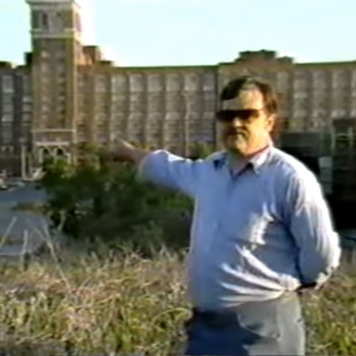The revered Atlanta musician Bruce Hampton collapsed onstage Monday night in the final moments of a tribute concert for him at the Fox Theater and died hours later in the hospital.
Most of the writing on Hampton this week has focused on the remarkable final curtain call of his life and on his musical legacy as one of the major figures in improvisational rock over the past fifty years.
Yet, with Hampton’s death, Atlanta has lost much more than just a great musician. As a friend of Hampton’s for the past two decades, I was always as impressed by his mind as I was by his music. A self-effacing person who saw himself as merely a clearinghouse for meaningless trivia, Hampton was a fount of encyclopedic knowledge about music, baseball, and Atlanta. On numerous occasions I witnessed him holding court, delivering a seemingly endless parade of facts and figures. While some of the trivia he passed along was definitely arcane, his intent in sharing it was far from meaningless. To him it was about sharing things he loved with others and about honoring his cultural and particularly his hometown heroes.
Hampton once said, “88 percent of my stories are true and the rest are embellished. I’d rather have somebody laugh at something I say than learn the weight of an onion in Idaho.”1 Hampton may have been more humorist than historian, but he had an uncanny way of connecting you to the past in personal and poetic ways. In the 1970s, he ran a local tour bus company and shuttled mostly out-of-town visitors around Atlanta, spewing a heady mix of accurate and fabricated details about the city.
To the right is a clip from “A Day in the Life of the Colonel,” a local Atlanta television program from the early 1980s built around Hampton’s particular perspective on life and the city. While some of the details Hampton provides about the old Ponce de Leon ballpark seem dubious (like Babe Ruth’s 752 mile home run), his deep love for the place makes it seem like the old ballpark is still there years after it was torn down. Atlanta is infamous for not preserving many of its historical sites, but, with Hampton, I always got the sense that long-gone places and people remained real and present in his consciousness. The city’s past and present blended into an imaginative space that was about 88 percent true.
Hampton once told me that one of his favorite Atlanta figures was Franklin M. Garrett, author of the seminal Atlanta history book Atlanta and Environs.2 Hampton loved Garrett not for the rigor of his scholarship but for his command of Atlanta trivia and for the idiosyncratic way that he spoke.3 A couple of years ago, Hampton and I came up with the idea to produce some short videos about Atlanta history with him playing the role of a Franklin Garrett–type expert. He mimicked Garrett’s clenched-jaw southern drawl and donned the moniker Dr. Bethune Workman. The videos we made were intentionally silly and sometimes less than 88 percent true, but, like the old Ponce de Leon ballpark clip, they also bore evidence to Hampton’s deep love and knowledge of the city.
In the video to the left, Hampton’s “Dr. Workman” provides stream-of-consciousness commentary while we drove around midtown and downtown. At the 2:40 mark in the video, we drive past the Fox Theater, and Hampton notes that Enrico Caruso played there in 1914 and retells a favorite urban legend that there are underground tunnels connecting the Fox and the Georgian Terrace hotel across the street.4 Hampton grew up going to the Fox. He saw Elvis there in 1959 and decades later performed at the theater periodically as a guest during big rock shows. And he graced the Fox’s stage one final time this past Monday night.
As many have noted, the musical world lost one of its most beloved figures with Hampton’s death. But with his passing Atlanta has also lost one of its biggest admirers and champions. I will deeply miss him and his hilarious ramblings about Atlanta’s past but feel grateful for the way he made me see the city as a landscape of living history.
Citation: Bransford, Steve. “Urban Legend: On Bruce Hampton’s Deep Love of Atlanta.” Atlanta Studies. May 05, 2017. https://doi.org/10.18737/atls20170505.
Notes
- Jerry Grillo, “Col. Bruce Hampton Says Goodbye.” Atlanta Magazine, May 3, 2017. http://www.atlantamagazine.com/news-culture-articles/col-bruce-hampton-says-goodbye/.[↩]
- Franklin M. Garrett, Atlanta and Environs: A Chronicle of Its People and Events, 3 vols. (Athens: University of Georgia Press, 1969, 1969, 1987).[↩]
- Franklin’s personality and command of the esoteric were on full display in the late 1980s when the Atlanta History Center put on a series called “Stump Franklin” where attendees tried to stump Garrett with obscure questions about Atlanta history. View an excerpt from a “Stump Franklin” event in 1988 on YouTube.[↩]
- This tall tale was still on Hampton’s mind on Monday morning when he was a guest on the WABE public radio show City Lights with Lois Reitzes along with Adina Erwin, the vice president and general manager of the Fox. At one point Hampton felt compelled to ask Erwin whether there really is an underground tunnel connecting the Fox and the Georgian Terrace. Erwin acknowledged that there are tunnels under the Fox, but said she was not aware of any tunnel that ever stretched under Peachtree Street to the hotel. Hampton, agreeing that “it’s probably urban legend,” said he still revels in retelling the story that, during Enrico Caruso’s extended residency at the Fox, he was “prissy” and demanded an underground tunnel be built to accommodate his movements between the hotel and the theater. Urban legends may make historians cringe, but Hampton loved them because they added a layer of mystery and fun on top of the city. See “‘Pushing Dead’; Col. Bruce Hampton; and More,” City Lights with Lois Reitzes, May 1, 2017, http://news.wabe.org/post/city-lights-pushing-dead-col-bruce-hampton-and-more.[↩]



